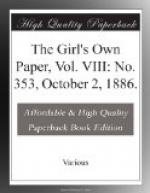The embroidery is used for table-cloths, mantel borders, and curtain brackets, knitting bags, handkerchief cases, and as a trimming to evening dresses. In all cases it requires a silk lining, and should be worked with a muslin lining beneath it. Embroidering Breton handkerchiefs is not a new description of fancy work, but it is still in vogue; and when a lady has had sufficient patience to successfully accomplish the feat of covering every portion of the handkerchief with thick filoselle work, there is no doubt that she has produced a piece of embroidery not only handsome and durable, but that will justly hand her name down to posterity as a real worker, and not one who takes up the whim of the hour and throws it on one side as soon as it bores her. The squares made of these embroidered handkerchiefs are shown more effectually when they are lined with quilted silk and used as banner-screens than when they are bordered with wide plush and used as table-cloths. The pattern in the latter case is never seen as a whole, and the beauty of the work is often marred by water from flower vases spilt over it, or wet teacups and saucers put down on it. The small screens now so fashionable make another admirable place for mounting Breton work. These screens are made of two compartments only, in height about 41/2 feet. To each panel, 21/2 feet from the ground, a ledge that can be put up or down is fixed, and that is used for holding a book or a teacup. The panel below this ledge is merely filled with a little curtain made of coloured Oriental silk, and arranged in very full folds. The panel above the ledge, that is fully displayed to every eye, is filled with the embroidery stretched quite tightly across it and displayed to its full advantage. The back of the embroidery is concealed with a satin or silk matching the little curtain beneath. Two Breton handkerchiefs are required, one for each division, but they should not be selected both of the same design. The little screens are made of oak, mahogany, and ebonised wood. They are a simple framework, an inch and a half square, and any working carpenter would make them to order.
Breton embroidery is too laborious for many people, and those whose time is much occupied with household matters, and who cannot devote much of it to the task of making their drawing-rooms pretty, we recommend to try crazy patchwork in its place. We have lately seen this easy work carried out most successfully, and used as mantel and table borders, covers for footstools, and as the centres of small table-cloths. The work is one of the least expensive that can be tried, and can be put down without derangement of effect at any moment (a great point in its favour where interruptions are frequent). Before commencing any piece of it, it is better to accumulate all the oddments of ribbons, plush, velvet, silk, and satin lying in the piece-drawer from dress trimmings or sent as patterns from shops. The more plush and velvet obtainable,




